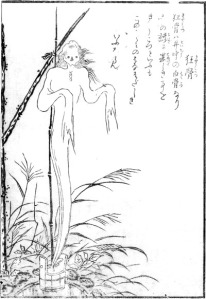
Translated and adapted from Hyakiyako Kaitai Shisho and other sources
Be careful when you pull up a bucket of water from an ancient, abandoned well. You might get more than you bargained for if a kyokotsu 狂骨—which translates literally as “crazy bones”—springs up from the bucket like a Jack-in-the-Box to deliver its curse.
Clad in a white burial kimono, kyokotsu almost look like a classical yurei but they lack the black/white contrast due to shocks of white hair that spring from its bleached-white skull. Kyokotsu appear as little more than bones wrapped in a shroud, springing from a well.
The yokai is best-known from Toriyama Sekien’s Edo-period yokai print-book “Konjyaku Hyaku Kishui” or “Supplement to the Hundred Demons of the Past.” Author Kyogoku Natsuhiko also recent featured a kyokotsu in his book “Dream of the Kyokotsu.”
Sekien’s original woodblock print was accompanied by this text:
“Kyokotsu rise from the bones in the well. It is said that whosoever commits the horrendous act of abandoning august bones will find it impossible to abandon the horrendous wrath that follows.”
Sekien’s text seems to explain that kyokotsu appear from a well in response to some wrongdoing and bearing a terrible grudge. Seiken also claimed that the regional-dialect term “kyokotsu,” meaning “violent” or “furious,” is an allusion to this yokai. However, while such a term does exist, specifically in Tsuki-gun in Kanagawa prefecture, there is no concrete evidence linking either the term or Seiken’s picture to an older folktale.
It is much more likely that the opposite occurred, that Seiken heard the term “kyokotsu” and decided to invent a yurei to match—much like if an English-language author decided to create a monster called “Lazy Bones” after the pre-existing term. To get the image for his yokai, Seiken was probably just playing on works, combining the local term “kyokotsu” (crazy bones) with “gyokotsu,” which means bones from which all of the meat has fallen off. He might also have been influenced by the words “keikotsu” or “sokotsu” which can mean drifter or wander, but also can be phrased as “someone from the bottom.” It seems likely that Seiken was influenced both by these words and by the old belief of an inexhaustible grudge that can come from the bottom of wells.
There are several Japanese folklore stories—involving both yokai and yurei—that involve the bottom of a well. In Japanese folklore, water was a channel to the world of the dead, and the bottoms of wells were directly connected. Wells also served as a convenient hiding place for murders committed in the dark of the night, and the superstitious believed that any such-disposed of corpse was capable of a powerful curse. Those who died from falling in wells, by accident, suicide, or murder, were thought to transform into shiryo and haunt the well. The spirit connects to the well itself, rather than where they were murdered, and their curse is likely to fall on anyone who used the well and not specifically targeted to the murderer.
A cursed set of bones is another typical trope in Japanese folklore and does not need to be connected to a well. In her book “Nozarashi Monogatari,” the literary scholar Sawada Mizuho wrote a similar story of a weather-beaten, abandoned skull that gets its revenge.
The biggest difference between the kyokotsu and typical Japanese folklore tales of skeletal ghosts is the element of disparity between the spirit form and the physical remains. In most stories, the spirit resembles a typical Japanese yurei—with a physical, full human body—even while the discovered remains are nothing more than a pile of rotting bones. The kyokotsu is rare in that Sekien drew the spirit in skeletal form as well. Because of this, kyokotsu is most often identified as a type of yokai, being a possessed skeleton, rather than a type of yurei, a Japanese ghost.
Translator’s Note: The manga series “Bleach” has a character called Katen Kyōkotsu that uses the same kanji as this yokai, but seems to have no other relationship.



Dec 14, 2011 @ 11:45:49
These posts are always so fascinating to read, thank you so much for sharing!
Dec 14, 2011 @ 13:05:48
Thanks Rei! I appreciate the comments. Always nice to know someone is enjoying my efforts!
Dec 14, 2011 @ 16:06:17
Thank you for the interesting post. I found this blog earlier via someones blogroll (I was clicking away, so unfortunately I do not remember where). I just finished reading this post, liked it and will now continue browsing your archives. Keep em coming!
Dec 14, 2011 @ 18:58:39
Thanks Steffen! Glad you found my blog!
Dec 14, 2011 @ 20:01:28
Marvellous!
Oct 30, 2012 @ 11:41:15
Zack, I really appreciate your work. Thank you so much!
May 28, 2013 @ 21:54:13
Hahaha! Even Bleach has a mention! What mangas do you read?
May 29, 2013 @ 08:28:17
To be honest, I don’t actually read a lot of manga. I mainly read Mizuki Shigeru’s stuff, which I also translate for Drawn & Quarterly (Like this one http://www.amazon.com/Showa-1926-1939-A-History-Japan/dp/1770461353/)
Other than that … just random stuff. I recently read Hiroaki Samura’s “Emerald and Other Stories” and wrote a review for it:
http://www.comicsbulletin.com/reviews/5753/review-emerald-and-other-stories-shows-off-hiroaki-samuras-range/